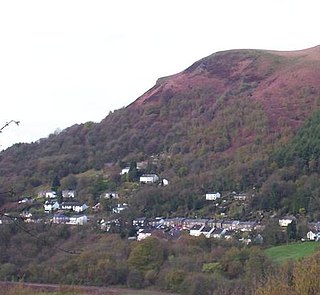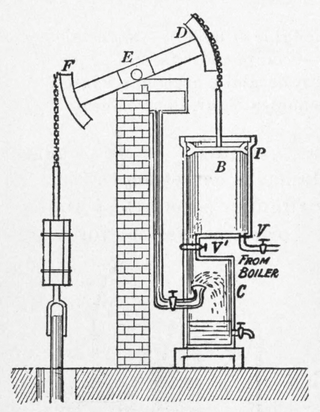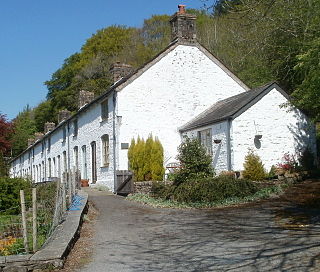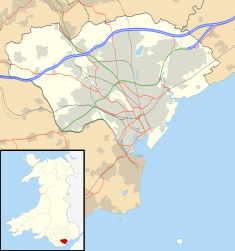
The Glamorganshire Canal in South Wales, UK, was begun in 1790. It ran along the valley of the River Taff from Merthyr Tydfil to the Bristol Channel at Cardiff. The final section of canal was closed in 1951.

Gwaelod-y-Garth is a village in the community of Pentyrch, Cardiff in Wales.

The River Taff is a river in Wales. It rises in the Brecon Beacons as two rivers, the Taf Fechan and the Taf Fawr before becoming one just north of Merthyr Tydfil. At Cardiff, it empties into the Bristol Channel.

Claverton Pumping Station in the village of Claverton, in the English county of Somerset, pumps water from the River Avon to the Kennet and Avon Canal using power from the flow of the river. It is a Grade I listed building, having been upgraded from Grade II in 2019.

Whitchurch is a suburb and community in the north of Cardiff, capital of Wales. It is approximately 3 miles north of the centre of the city on the A470 road and A4054 road. It falls within the Whitchurch & Tongwynlais ward. The population of the community in 2011 was 14,267.

A beam engine is a type of steam engine where a pivoted overhead beam is used to apply the force from a vertical piston to a vertical connecting rod. This configuration, with the engine directly driving a pump, was first used by Thomas Newcomen around 1705 to remove water from mines in Cornwall. The efficiency of the engines was improved by engineers including James Watt, who added a separate condenser; Jonathan Hornblower and Arthur Woolf, who compounded the cylinders; and William McNaught, who devised a method of compounding an existing engine. Beam engines were first used to pump water out of mines or into canals but could be used to pump water to supplement the flow for a waterwheel powering a mill.

CSS Muscogee was an casemate ironclad built in Columbus, Georgia for the Confederate States Navy during the American Civil War. Her original paddle configuration was judged a failure when she could not be launched on the first attempt in 1864. She had to be rebuilt to use dual propeller propulsion. Later renamed CSS Jackson and armed with four 7-inch (178 mm) and two 6.4-inch (163 mm) cannons. She was captured while still fitting out and was set ablaze by Union troops in April 1865. Her wreck was salvaged in 1962–1963 and turned over to the National Civil War Naval Museum in Columbus for display. The ironclad's remains were listed on the National Register of Historic Places in 1970.

Cwmavon is a hamlet about 2 miles south of Blaenavon and 4 miles north of Pontypool. The hamlet is part of the community of Abersychan in the county borough of Torfaen in south east Wales, and is within the boundaries of the historic county of Monmouthshire.

The Aberdare Canal was a canal in Glamorgan, Wales which ran from Aberdare to a junction with the Glamorganshire Canal at Abercynon. It opened in 1812 and served the iron and coal industries for almost 65 years. The arrival of railways in the area did not immediately affect its traffic, but the failure of the iron industry in 1875 and increasing subsidence due to coal mining led to it becoming uneconomic. The Marquess of Bute failed to halt its decline when he took it over in 1885, and in 1900 it was closed on safety grounds. The company continued to operate a tramway until 1944. Most of the route was buried by the construction of the A4059 road in 1923, although a short section at the head of the canal remains in water and is now a nature reserve. The company was wound up in 1955.

Blaenavon Ironworks is a former industrial site which is now a museum in Blaenavon, Wales. The ironworks was of crucial importance in the development of the ability to use cheap, low quality, high sulphur iron ores worldwide. It was the site of the experiments by Sidney Gilchrist Thomas and his cousin Percy Gilchrist that led to "the basic steel process" or "Gilchrist–Thomas process".

Old Bess is an early beam engine built by the partnership of Boulton and Watt. The engine was constructed in 1777 and worked until 1848.

The Melingriffith Tin Plate Works were post medieval tin and iron works located on Tŷ-mawr Road, in Whitchurch, Cardiff, Wales. Founded sometime before 1750, it was the largest tin-plate works in the world by the end of the 18th century. Subsequent to the closure of tin plate works in 1957, the 200-year-old Melingriffith water pump was named a scheduled monument. It is one of the earliest and most important works of its kind, and may be "the most notable surviving monument of the tinplate industry".
The Melingriffith Brass Band of the Melingriffith Tin Plate Works of Whitchurch, Cardiff, south Wales, is a brass band that was one of the best known music ensembles in South Wales in the late 19th and early 20th century. It is also arguably Wales's oldest, originally established in 1798 as a Drum and Fife Band to "assist the recruitment of a Company of Volunteers to fight against the French, who were threatening to invade Britain." With the 13th Glamorgan Rifle Volunteers Corporation, in 1850 it became a full brass band and led by T.W. Booker and would practice in the New Houses, a row of workers cottages at the works. In the 1860s and 1870s the band was known as "Booker's Band" but it appears that the band was subject to splitting and by the 1880s and 1890s "The Volunteer Band", "The Temperance Band" and "The Drum and Fife Band" were known to exist until the Volunteer and Temperance bands merged to form "The Whitchurch Brass Band" as it became known in the early 20th century. In 1913, the Whitchurch Brass Band merged with the Melingriffith Cadet Corps. The band was led by Thomas James Powell from 1920 and in 1941 changed its name to the "Melingriffith Works Band". The headquarters were moved in 1937 from a small hall just above the works on Velindre Road to a building within the works between the River Taff and the Glamorganshire Canal. The band performed on Castle Street in June 1947 when the fifth Marquess of Bute ceded Cardiff Castle to the City of Cardiff.

Fairbottom Bobs is a Newcomen-type beam engine that was used in the 18th century as a pumping engine to drain a colliery near Ashton-under-Lyne. It is probably the world's second-oldest surviving steam engine. The engine was installed at Cannel Colliery at Fairbottom near Ashton-under-Lyne around 1760 or 1764. It became known locally as Fairbottom Bobs.

Calvert's Engine or the Newbridge Colliery Engine is a beam engine of 1845, now preserved on the campus of the University of Glamorgan, South Wales.

The Newcomen Memorial Engine is a preserved beam engine in Dartmouth, Devon. It was preserved as a memorial to Thomas Newcomen, inventor of the beam engine, who was born in Dartmouth.
Watkin George (1759-1822) was an carpenter, engineer and ironmaster from Trevethin in Monmouthshire. He rose from humble beginnings as a carpenter to have a major influence on ironworks at Cyfartha and Pontypool and is responsible for the design of early cast-iron bridges.

Porth Wen Brickworks first built by Charles E Tidy, is now a disused Victorian brickworks which produced fire bricks, made from quartzite (silica) used to line steel-making furnaces. The substantial remains include a number of buildings and the remains of some of the machinery, but has some damage from sea erosion. The site is a scheduled monument.

The Treforest tinplate works in Treforest, Wales, operated between the late 18th century and 1939. The six remaining buildings on the site were constructed in the mid 19th century during which time the iron and tinplate industries were dominated by South Wales. These buildings form the best surviving group of tinplate manufacturing buildings in the region and are Grade II* listed.


















